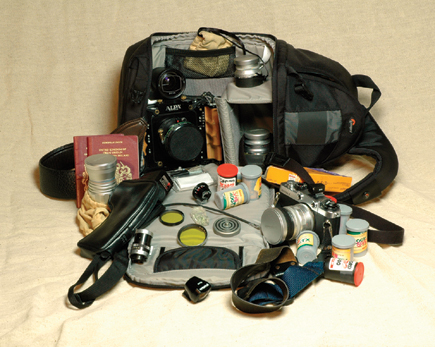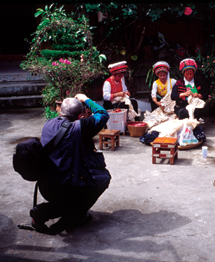Traveling With A SlingShot; A New Take On A Popular Style
Slingshots may seem like odd travel accessories, but these SlingShots are two
dispatch rider-style backpacks--also known as bandoleer bags and, yes,
sling bags--from Lowepro.
They are part of the "Designed for Digital" range, but don't
let that worry you: they are at least as good for film cameras. Yes, they are
designed especially for carrying a digital SLR and all of the accessories you
need; they are very compact; there are built-in pockets for media cards; there
is a special built-in microfiber screen protector. While this makes them ideal
for digital, it does no harm at all with non-digital. In fact, I'd say
that they are just about perfect for rangefinder cameras.
 |
|
|
On a recent trip to China, for example, I carried two Voigtländer rangefinder
bodies (Bessa R2 and Bessa-T), an Alpa 12SWA, five lenses (four Voigtländer,
one Alpa), five filters, two cable releases, a spirit level, four viewfinders
(Voigtländer 21, 28/35, and 90, and Tewe 35-200), cleaning kit, and film!
I admit the bag was well stuffed but it stood up to the abuse and kept my equipment
secure and accessible. This was all in the 200 AW, the bigger version: its little
brother the 100 AW is perfect for a day out with one camera, a couple of lenses,
and the requisite accessories. Both have padded backs (so your cameras don't
stab you in the back) and a built-in folding "rain hat" of waterproofed
rip-stop nylon which also provides additional security on mean streets.
This style of one-strap bag is increasingly popular, and deservedly so, but
what really makes the SlingShot special is the way it opens. Unzip the main
compartment fully for packing and unpacking. This opens two faces of the bag,
the front and the left side: a lot easier to understand than to describe, but
I'll try.
When you carry the bag, you have the shoulder strap slung across to your right
shoulder. A sternum strap holds it firmly in place--another excellent idea
that distinguishes the SlingShots from many of their competitors. Lowepro calls
the sternum strap a "stability strap," and that's a pretty
fair description. Both the main strap and the sternum strap have quick-adjustment
buckles: pull the loose end to tighten, lift the buckle to allow it to loosen.
The sternum strap can also be tucked away into a little pocket to stop it trailing
when it's not in use.
 |
|
|
Undo the sternum strap and pull the bag around to the front, and the side
opening becomes a top opening. "Zip-Stop" buckles stop you from
opening the bag too far and dumping all your gear. The top opens away from you
so you can see what is inside and even use it as a workbench. When using the
bag this way it is like using a conventional shoulder bag, but it is more comfortable
for carrying long distances.

































